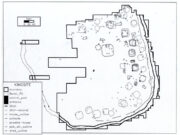The King site is a mid-sixteenth-century aboriginal town located on the Coosa River in western Floyd County in northwest Georgia. This archaeological site, which was excavated by researchers at Shorter University in Rome, covers a little more than five acres and is bounded by a defensive ditch and palisade.
A plaza occupied the center of the town and contained at least two public buildings: structure 17, measuring fifteen meters square and filled with benches, probably functioned as a meeting house; structure 16, the smaller of the two, is of unknown function. South of these buildings, in the exact center of the town, is a large posthole that probably held a post measuring almost one meter in diameter and six to ten meters in height. The habitation zone contained two types of domestic structures: square, semi-subterranean houses with peaked roofs and earth-embanked walls; and rectangular corn cribs elevated two meters or so above ground. The former were domestic residences utilized during the cooler months of the year. The latter were used for storage of foodstuffs and provided a shaded space for domestic activities during the summer months. Household members were buried beneath both types of structures and in the outdoor space surrounding them. Ten adult males were interred beneath the floor of the meeting house.
The King site was first occupied at some time during the first half of the sixteenth century with the construction of half a dozen or so domestic structures. Within a decade additional households appeared, and the town was formally laid out with its defensive perimeter, plaza, and habitation zone. The town existed in this form for twenty to thirty years and then was abandoned. During its existence it was probably visited by members of the Hernando de Soto (1540) and Tristan de Luna (1560) expeditions. Iron tools and a sword were interred with a small number of burials. The iron tools were probably obtained in trade from the Spanish, while the sword may have been obtained by other means. Whether the town’s abandonment was a result of Spanish contact is not known.




